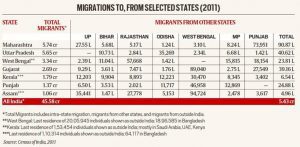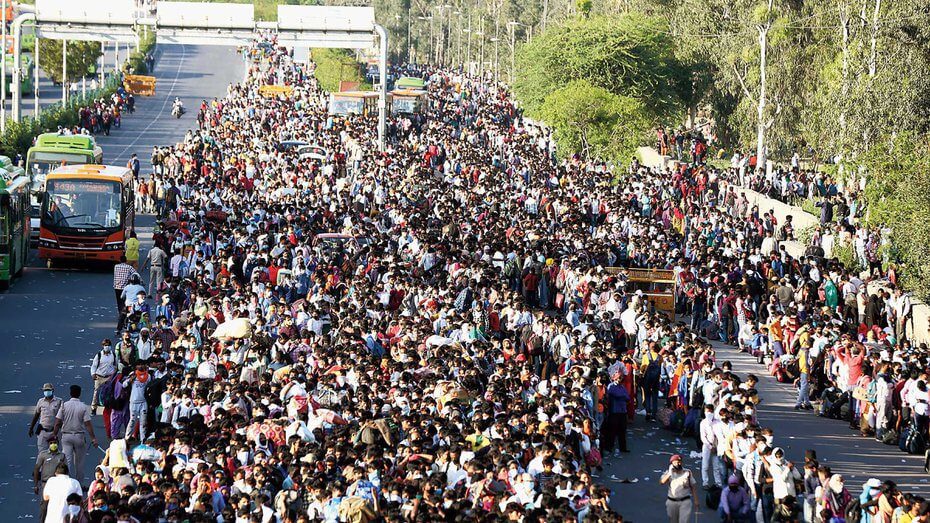Reading Time: 6 minutes
Shyamal analyses the plight of the migrant labourers, who are part of the informal sector of the Indian economy, in the light of the Covid pandemic nationwide. An exclusive for Different Truths.
I start with a story.
A photojournalist Kevin Carter had been covering disastrous famine of the 90s in Sudan when he took a shot of a dying child and an awaiting vulture by chance during his journalistic detour. The photo captioned ‘The vulture and the little girl’ brought Carter Pulitzer honours.
A photojournalist Kevin Carter had been covering disastrous famine of the 90s in Sudan when he took a shot of a dying child and an awaiting vulture by chance during his journalistic detour. The photo captioned ‘The vulture and the little girl’ brought Carter Pulitzer honours.
Later, during a reception, one gentleman asked, “Mr Carter, what happened to that girl eventually?”
Carter replied, “No idea. I needed to rush for my flight.”

The person asked, “How many vultures you noticed — only one?”
Carter said, “Possibly.”
The person asserted, “No sir, I could see two vultures – the other one holding a camera.”
Carter was terribly distressed and later mentally frustrated to commit suicide for whatever reasons.
The prologue refers to the continuous eye-catching photo coverage daily on all kinds of media referring to the plight, woes and worries of the lost job, masses and their consequent homebound exodus out of fear from quarantine, uncertain future and hunger. No doubt, the stark realities of the situation with supportive pictures help to raise up sales and TRP for the print as well as audiovisual media but have these not been proactively brought into the public domain, neither we would know nor the authorities would have taken cognizance of the massive fallouts of the pandemic.
The prologue refers to the continuous eye–catching photo coverage daily on all kinds of media referring to the plight, woes and worries of the lost job, masses and their consequent homebound exodus out of fear from quarantine, uncertain future and hunger.
To look through, the Coronavirus does continue to affect the population of almost all countries and lack of prior knowledge and effective remedial drugs, it has been extremely deadly for the human. Each country has evolved its own strategy of social distancing with the protocol for countrywide lockdown for all sorts of commercial and individual movements and in open activities. Thus far, India also remains on the same global platform and WHO standardised procedures.
The chink appears to have come, on our shield to fight the pandemic, out of our vast magnitude of the workforce engaged in the non-formal or unorganised sector of our country. No other nation (data not available for China) comprises their economy with this level of contribution from the unorganised (non- agriculture) sector business and allied enterprise, as traditionally prevailing in India.
As per the Economic Survey (2018-19), more than 90% of our working population is engaged in the unorganised sector, which includes the self–employed. Niti Ayog figures for workers in the unorganised sector are around 86% of the total workforce. Numerically, out of a total of 45 cr. employed persons, nearly 42 cr. work in the informal or unorganised sector.
As per the Economic Survey (2018-19), more than 90% of our working population is engaged in the unorganised sector, which includes the self-employed. Niti Ayog figures for workers in the unorganised sector are around 86% of the total workforce. Numerically, out of a total of 45 cr. employed persons, nearly 42 cr. work in the informal or unorganised sector. When one looks at the employment vector, further revelations come as a shocker. Nearly 70% of the workers in the unorganised sector are paid wages informally without any type of contract/agreement; no paid leave apart. However, we need to bear, all available data in respect of the informal sector are itself unverifiable or informal and at variances from one to other.
Shamefully, even after 72 years of independence, the Minimum Wages Act has not been effectively implemented, admitted in the Economic Survey — one in every three wagers fallen through the crack. These workers have no welfare supports, no work hours limit or not all covered under Unorganised Workers` Social Security Act 2008 — alleged all trade unions.
In terms of UNO Report on Hunger, India ranks 102 amongst 117 countries as per Hunger Index and 14% of our total population of approximately 135 cr. are under-nourished or without diets. For sure, as a nation, we have failed to ensure a minimum guarantee of wages and diet to a vast majority of our countrymen
In terms of UNO Report on Hunger, India ranks 102 amongst 117 countries as per Hunger Index and 14% of our total population of approximately 135 cr. are under-nourished or without diets. For sure, as a nation we have failed to ensure a minimum guarantee of wages and diet to a vast majority of our countrymen, despite a number of committee reports, policy programmes and budgetary outlays.
This is the untold tale and unkindest of efforts to alleviate poverty and hunger for the mass. The consequences have forced people to shift or to settle for comparatively greener pastures, elsewhere, away from their home, intrastate or interstate: these are people — the operative force in various manufacturing units, trade and business, eating houses, construction works and self-employed professions as encompassed in the informal arena.
The people migrating out of home states are because of squeezing employment opportunities, reducing farmland, perpetual indebtedness and poverty as common existential reasons. Their presence creates incentives to the economy of cities or states they get settled seasonally or permanently
The people migrating out of home states are because of squeezing employment opportunities, reducing farmland, perpetual indebtedness and poverty as common existential reasons. Their presence creates incentives to the economy of cities or states they get settled seasonally or permanently; their wages, savings and remittances help boost the economy of the original home.
As per 2011 census, the total figure of migrant people arrived at 45.58 cr. out of whom 39.57 were intra–state and remaining interstate. Half of the total migrated people shift from U.P. and Bihar to other states and there continues a steady flow of job seekers from neighbouring Bangladesh, Nepal and others. Despite the existence of so vast migrated workforce, no official count or record is maintained at any level except collating from records scattered at different agencies or departments.
 As per 2011 census, the total figure of migrant people arrived at 45.58 cr. out of whom 39.57 were intra-state and remaining interstate. Half of the total migrated people shift from U.P. and Bihar to other states and there continues a steady flow of job seekers from neighbouring Bangladesh, Nepal and others. Despite the existence of so vast migrated workforce, no official count or record is maintained at any level except collating from records scattered at different agencies or departments. A few years back, in 2012 Committee on Unorganised Sector, set up by National Statistical Commission noted — 50% of GNP contributed by the sector but lack of reliable data on size, distribution and share of the informal sector had been a constraint to the understanding of its significance in the development planning. Even in recent past, a study by ISID affiliated to ICSSR suggested reforms to push the sector and its workforce.
As per 2011 census, the total figure of migrant people arrived at 45.58 cr. out of whom 39.57 were intra-state and remaining interstate. Half of the total migrated people shift from U.P. and Bihar to other states and there continues a steady flow of job seekers from neighbouring Bangladesh, Nepal and others. Despite the existence of so vast migrated workforce, no official count or record is maintained at any level except collating from records scattered at different agencies or departments. A few years back, in 2012 Committee on Unorganised Sector, set up by National Statistical Commission noted — 50% of GNP contributed by the sector but lack of reliable data on size, distribution and share of the informal sector had been a constraint to the understanding of its significance in the development planning. Even in recent past, a study by ISID affiliated to ICSSR suggested reforms to push the sector and its workforce.
When the authorities declared pandemic and subsequent stringent lockdown formalities, it came as a bolt from blue on the country`s already ailing economy, no matter it has been happening on the world economy, strong or weak. The organised sector was able to adjust and adapt different lines of operational procedures albeit slowly but the entire informal sector (farm and nonfarm ) has come to halt nationwide, abruptly, without cushioning time alike demonetisation saga. Obviously, the workforce engaged in this sector lost job with activities shut, gradually lost saved money (if at all ) to pay for food, rent and essentials. Thus, commenced since March-end 2020, the Great Exodus of the workforce for life and security from the unorganised and partly also organised sector to the home out of fear and to escape from Covid, hunger and administrative excesses.
The lack of coordination, planning, backup synergy and quick response caused great mess and havoc to the homeless hunger-stricken people and their families, wandering on highways, railways or bus stands.
The lack of coordination, planning, backup synergy and quick response caused great mess and havoc to the homeless hunger-stricken people and their families, wandering on highways, railways or bus stands. No doubt misinformations had been floated from vested sources but inept and insensitive handlings by the administration, who were caught off-guard, only aggravated the intensity of the critical situation.
But for continuous highlights in the media, the subsequent corrective steps undertaken by the authorities would likely to be delayed farther. To condemn media on focusing too much on migrants’ distress as adversarial to the authority is a manifestation of despondency not compatible with our human and democratic values. We all need to move along, take along and grow along to combat the crisis and to assist the distressed for a better India.
Photo from the Internet

















